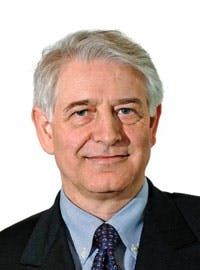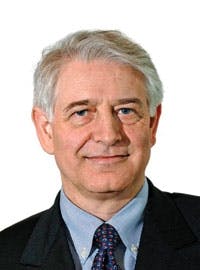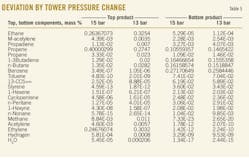Since mid 2009, Royal Dutch Shell PLC began streamlining its organization for carrying out major projects.
Matthias Bichsel became director of Shell's Projects & Technology group in July 2009 and in an interview with OGJ explained that Peter Voser, who last year became chief executive officer of Shell, initiated Shell's reorganization so that the company would become leaner and fit for the next phase of growth.
The reorganization was announced in May last year and the Projects & Technology group was formally launched at the start of 2010.
Bichsel said that for a period Shell had underinvested and did a considerable amount of catch up during the high-cost environment of 2004-09, so that one focus for the new organization is the reduction of costs.
New organization
Shell's Projects & Technology group combines previously somewhat autonomous upstream, downstream, and gas and power project groups. Under the old organization each of these groups had its own research and development, projects, contracting and purchasing, and safety and environment units.
A head of research managed each of the old R&D units but in the restructured organization, Shell now has only one R&D group headed by one executive chief technology officer and therefore has become effectively leaner, Bichsel explained.
He added, instead of different approaches, standards, and definitions for upstream and downstream, the approach to R&D and projects is now common across the company. Bichsel noted that the old approach was "a waste and something that did not add value." The new organization will provide the glue between upstream and downstream organizations, he added.
He noted "The reorganization was a way to get rid of some overhead while maintaining the R&D focus on research."
He explained that when Voser was chief financial officer at Shell he introduced the concept of ESSA, which stands for elimination, simplification, standardization, and automation. The idea is to eliminate complexity then simplify and then standardize and automate where you can, Bichsel said.
He said the Projects & Technology group will focus on projects with a $500 million overall basis and do projects in parts of the world where Shell's existing operating units do not have sufficient capacity such as in Iraq.
In regard to drilling, the group will oversee drilling in new exploration areas, deepwater drilling, and link all of Shell's drilling abilities on a global scale, Bichsel said.
Another function of the group is globally to leverage technologies such as those developed for producing tight and shale gas and transfer the technology to other parts of world such as China, where Shell is exploring for shale gas, he said.
Bichsel also noted that the new structure provides the opportunity for a unified contracting and procurement team to leverage Shell's worldwide buying power. According to Bichsel, the oil and gas industry is taking less advantage than other industries in purchasing equipment and materials from China, India, and Mexico. These countries offer many benefits, he said.
For example, he added that Vietnam is another country with emerging opportunities for supplying equipment, although currently that country still lags in its industrial capabilities compared with others in the Far East.
Projects
Shell's Projects & Technology group recently has been finishing several large legacy projects such as BC-10 off Brazil, and Perdido in the Gulf of Mexico.
BC-10 started up in July last year and now is producing more than 100,000 bo/d, he said, and Perdido has just come on stream.
Also Shell has two large projects nearing completion in Qatar: Pearl GTL and Qatargas 4 LNG, he said.
Bichsel explained that these projects are starting to generate extra cash flow that will allow for new growth and that Shell currently has about 35 projects in the design and study phase to choose from.
Regarding more GTL plants, Bichsel said Shell does not have firm plans yet for more, but the technology offers a way to turn low-cost gas into a higher priced oil product.
He believes LNG is a growth area, although development of large quantities of shale gas in the US has been pushing out LNG from that market. But Bichsel expects countries such as China, India, and Pakistan to need additional LNG to fuel their growth.
He said the projected growth in energy needs in India is enormous. Although currently India is looking at coal for its increased energy needs, he expects that LNG would offer an attractive alternative.
Shell is continuing to advance its floating LNG technology for monetizing stranded gas in fields far offshore. The Shell-operated Prelude field off Australia will be the first field developed with an FLNG vessel, and Woodside Petroleum Ltd.has selected one for the Greater Sunrise gas development in the East Timor-Australia joint petroleum development area in the Timor Sea.
Bichsel expects the cost of FLNG vessels to decrease because of Shell's approach to "design one-build many."
He said Shell's idea is to use generic FLNG vessels that are 80% the same with the rest of the design based on the actual gas specification of a field. "The idea is to get a tram line so that each 18-24 months a new FLNG vessel can be built," he said.
In this approach, Shell would profit from an experienced work force similar to Shell's experience in building five tension-leg platforms for the Gulf of Mexico, he added. For instance, he said the last TLP, Brutus, commissioned in 2001, had a normalized cost that was about 40% less than the first TLP.
Cost Focus
Shell also plans to lower costs by reducing the hull size for production facilities such as its design for the Mars B tension-leg platform, Bichsel said.
Shell is designing the Mars B tension-leg platform in-house with the assistance of contractors, but for designing platforms in Asia it will likely have to use tenders for designing platforms, he said. He explained that some countries and joint ventures require a tender process for acquiring facilities while for the Gulf of Mexico the government does not dictate the purchasing process.
Another project that Shell has for lowering costs is the Bully rig. Shell working together with Frontier Drilling, Huisman, and GustorMSC developed the Bully-concept for ultradeepwater drilling.
Bichsel noted that the Bully drillship is 25% shorter and 40% lighter than comparable capacity drillships (see figure) and has the potential to cut deepwater drilling costs compared with the current market price.
Two Bully rigs currently are under construction in Singapore and Bichsel said one should be operating in the Gulf of Mexico early next year with the second Bully rig to follow in 4-5 months.
He said the idea for the Bully rig started in 2005 when rig rates were in the $200,000/day and then went on to exceed $700,000/day.
The rigs have a fifth-generation capability and the first one being built has Arctic capabilities and can drill in both shallow and deep water.
Bichsel said Shell's Canada oil sands are moving nicely with the coming on stream of the Athabasca Oil Sands Project Expansion 1 towards yearend. He said the company also has identified a number of debottlenecking opportunities for the short term and expansionoptions for the longer term.
Another opportunity for Shell is its Iraq contract in Majnoun field. Bichsel said Shell has people in Iraq that are working with the Southern Oil Co. on the first phase as well as doing a development study on the full development of the 38 billion bbl field.
Career highlights Matthias Bichsel is a member of the executive committee of Royal Dutch Shell PLC and director of projects and technology as of July 1, 2009. The project and technology group combines major project delivery, technical services and technology development and deployment in Shell. In addition, Bichsel oversees Shell's safety and environmental performance. Experience Bichsel has worked for Shell companies and affiliates in Bangladesh, Oman, Canada, Indonesia, US, and Netherlands. In 1995, he was selected as director of Petroleum Development Oman to look after exploration and deep oil field developments. In 1999, he transferred to Houston as managing director of Shell Deepwater Services, involved in all aspects of worldwide deepwater exploration and development. From 2002-06, he managed as executive vice-president, Shell's global exploration activities and performance. From 2006 until mid 2009, he was executive vice-president—technical, for Shell Exploration and Production. Education Bichsel holds a doctorate in geology from the University of Basel, Switzerland. Organizations Bichsel is a member of AAPG and SPE, where he currently is a member of the industry advisory council. |
He explained that in the first phase Shell has to deliver certain oil production before starting to recover costs. He added that all the big western service companies are in Iraq and can provide rigs and services for developing the field.
Shell just finished a large petrochemical complex in Singapore (OGJ Online, May 7, 2010) but for now has no firm plans for new major downstream projects, Bichsel said. He also noted that Shell has announced divestment of about 15% of its refining capacity and is also reducing its retail markets.
Safety
Safety and environmental oversight is another function of Shell's Project and Technology group.
Bichsel said that in regard to deepwater drilling safety, Shell places an emphasis on three parts: proper training, compliance with standards, and the right tools and equipment.
He said that the training includes exams for the drilling staff that they must pass before being allowed to work. About 20-25% fail, he noted.
After the recent Deepwater Horizon blowout in the Gulf of Mexico, Bichsel said Shell stood down all its rigs to make sure all were in compliance with the company's standards.
Another stringent requirement of Shell, Bichsel said, is that all key drilling equipment must be stripped, inspected, and recertified by their manufacturers every 5 years.
More Oil & Gas Journal Current Issue Articles
More Oil & Gas Journal Archives Issue Articles
View Oil and Gas Articles on PennEnergy.com




